Learning how to make Eggs Benedict doesn’t have to be intimidating or complicated. This foolproof recipe breaks down the classic brunch dish into simple steps, featuring an easy blender hollandaise that will make you feel like a pro chef without the fuss!
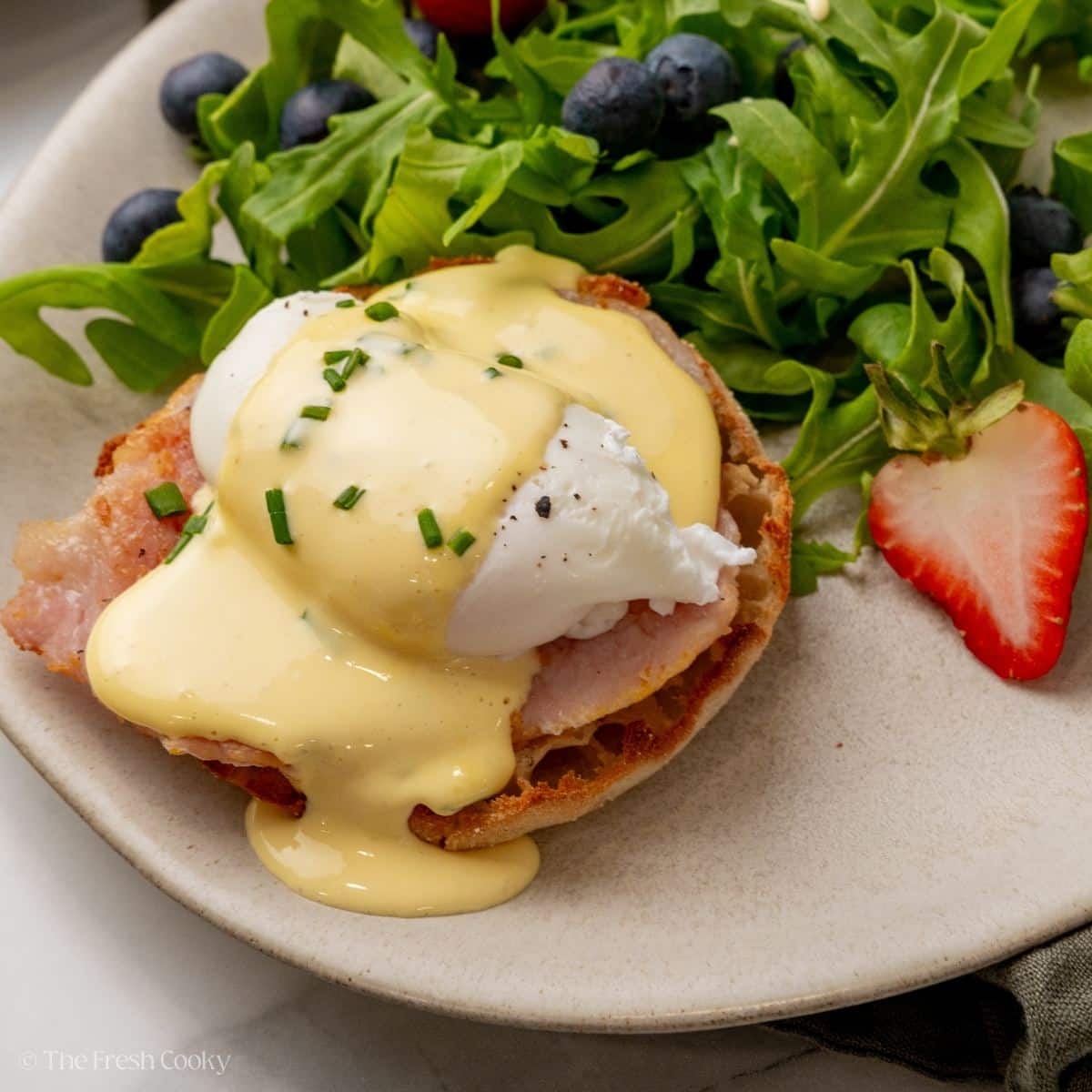
Why You’ll Love This Classic Eggs Benedict Recipe
Eggs Benedict is my favorite breakfast, and one I rarely indulge in except when going to a restaurant or a special occasion. But I thought it was high time I shared my foolproof recipe with you!
Don’t fear the hollandaise! I used to think hollandaise sauce was for those with a culinary degree. Spoiler alert: it’s not! My blender method is so easy that you’ll wonder why you ever thought it was complicated. If you can melt butter and press a button, you can make this sauce.
Poached eggs aren’t as scary as they sound. With a few simple tricks (hello, vinegar + gentle swirl), you’ll be poaching like a pro. All the tips for the perfect, no snotty whites, perfectly cooked yolks!
It’s our go-to “impress without stress” brunch. Whether it’s a lazy Sunday or a special breakfast for guests, this dish always gets a wow. And once you get the rhythm down, you’ll be surprised how doable it is. Even my 10-year-old son (at the time) easily (with a bit of oversight) made this Eggs Benedict recipe!
Adaptable. Not a fan of Canadian bacon? Try smoked salmon. Going low-carb? Skip the muffin. Need gluten-free? Easy peasy. Love spinach, try this Eggs Benedict Florentine. Bottom line, this recipe is super flexible and feels like a treat. Check out my variations!
Years of testing = no-fail tips for you. Let’s be real—I’ve made (and messed up) a lot of hollandaise in my day. But through all that testing, I’ve created the easiest, most reliable steps so you don’t have to guess (or do a web search mid-brunch).
Watch how easy it is to make this recipe!

The Quick Dish on This Traditional Eggs Benedict Recipe
- Prep: Approximately 10 minutes – mostly to gather your ingredients and bring your water to a simmer.
- Cook: 10–15 minutes – thanks to blender hollandaise, you’ll eat sooner!
- Cuisine Inspo: A brunch-time classic with French flair and New York roots.
- Cooking Method: Poaching + Blending (Your blender does the heavy lifting!)
- Dietary Info: Protein-packed with a silky, buttery sauce—vegetarian if you skip the meat and gluten-free/low-carb without the muffin.
- Key Flavor: Buttery, tangy, savory, and a little lemony—balanced by that soft, golden runny (or jammy) yolk.
- Skill Level: Easy–Intermediate – especially with the blender sauce hack. Push a button and poach an egg (and yes, you CAN poach an egg)!
Classic Eggs Benedict Ingredients
- English Muffins: Use your favorite store-bought English muffins, or make homemade English muffins!
- Eggs: For the best poaching results, use super-fresh eggs. Older eggs will have more runny whites, which “feather” as they hit the water. Use eggs that are cold out of the fridge.
Pro Tip: Test your eggs by doing a quick float test—gently place the egg in a bowl of water.- Fresh eggs will sink and lay flat.
- Slightly older eggs may tip upright or float—those are better for baking or hard boiling, but not ideal for poaching.
- Canadian Bacon: You can use Canadian bacon or any sliced ham.
- White Vinegar: Add a splash to the poaching water to help the egg whites retain their shape.
- Butter: To sear the ham!
- Chives or Parsley: Top it all off with freshly chopped chives or parsley, or a sprinkle of paprika if you prefer.
For the Blender Hollandaise Sauce:
Be sure to check out my post with all the tips for how to make hollandaise sauce.
- Egg Yolks: Egg yolks create a silky and creamy sauce. Use pasteurized eggs (labeled on the carton); between pasteurization and the hot butter, it will “cook” the eggs enough that the sauce is safe to eat. Pro Tip: Separate the yolks from the whites when they are still cold, then bring the yolks to room temperature.
- Fresh Lemon Juice: For a hint of acidity, which adds brightness to the sauce.
- Dijon Mustard will help to emulsify the mixture and add tanginess.
- Butter: Hot butter helps to cook the egg yolks while creating a rich sauce. I used unsalted butter; if using salted, omit the salt.
- Kosher Salt: To taste.
- Cayenne Pepper: For a hint of spice, you can add cayenne pepper or a dash of hot sauce.
Get the full recipe in the recipe card below.

Eggs Benedict Sauce
Instead of a traditionally cooked hollandaise, which can be temperamental, I’ve opted for a blender hollandaise. There’s no direct heating—just adding hot, melted butter provides enough heat to safely “cook” the eggs. (Source)
How to Make Eggs Benedict with Hollandaise Sauce
Step 1 – Easy to follow Step-by-Step Instructions
Toast the English muffins until golden brown, butter if desired. Pro Tip: Place the toasted English muffin halves on a baking sheet and warm them in a 300°F oven for 5-7 minutes—this keeps them crisp on the outside and soft on the inside.
How to toast English muffins in the oven
To toast English muffins in the oven, preheat your oven to 400ºF (205° C) and split the muffins with a fork to preserve those signature nooks and crannies. Place them cut-side up on a baking sheet and bake for 8–10 minutes, or until golden and crisp. For extra crunch, flip them halfway through. If you prefer a softer inside with just a lightly crisp edge, toast them at 375ºF for 6–8 minutes instead.

Step 2 – Sear the Canadian Bacon
Melt butter in a pan over medium-high heat. Cook bacon slices until lightly browned, 2-3 minutes per side. Set aside.

Step 3 – Poach the Eggs
Bring a large saucepan filled with approximately 3 inches of water to a boil over high heat, then reduce the heat to keep the water at a simmer. Add vinegar. Stir the water using a spoon for 10 seconds to create a vortex.
Add one egg to the center of the pot, so the whites of the egg wrap around the yolk. Cook for 3 to 5 minutes, or until the egg whites are cooked but the yolk is runny. Longer cooking will result in firmer whites and a runny, jammy yolk. Remove with a slotted spoon and drain on paper towels. Season with salt and pepper, if desired. See tips for poaching at high altitude.
Poach ahead! After poaching, immediately place the poached eggs in ice water to stop the cooking process, then transfer them to paper towels. Reheat for 30–45 seconds in hot simmering water when ready to serve—perfect for brunch crowds.
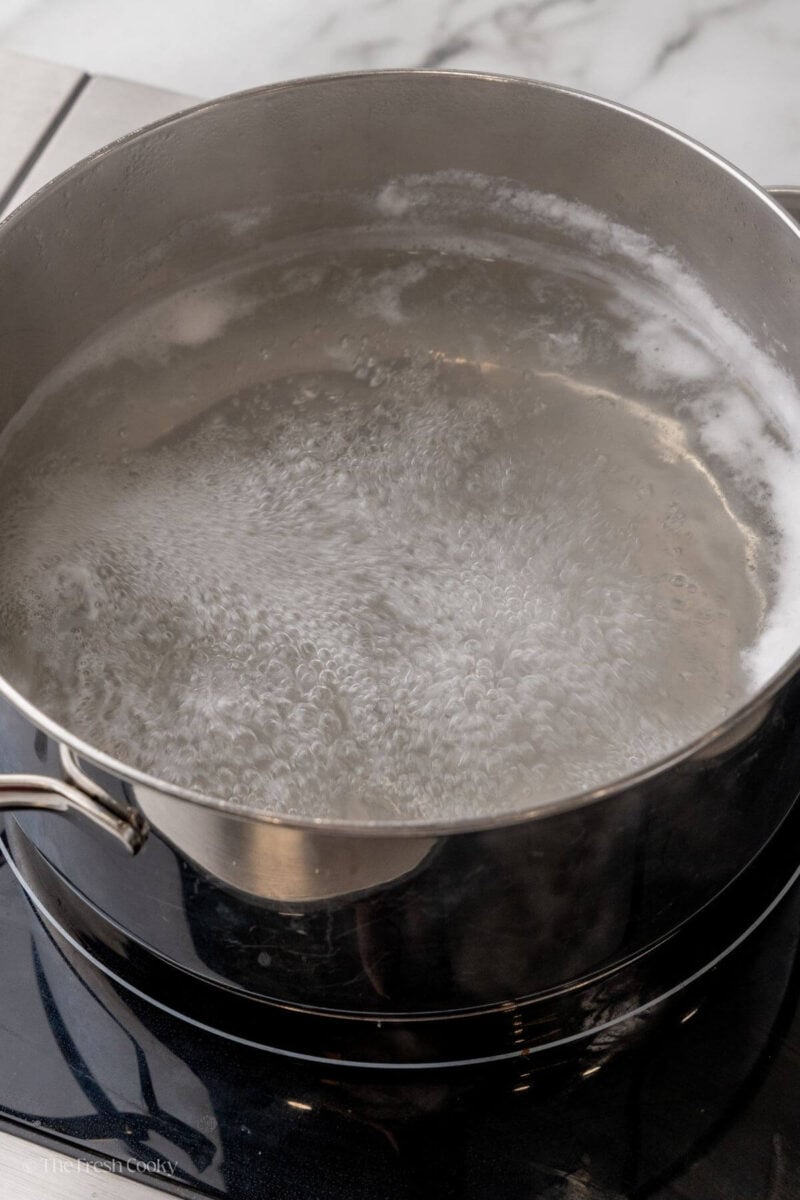
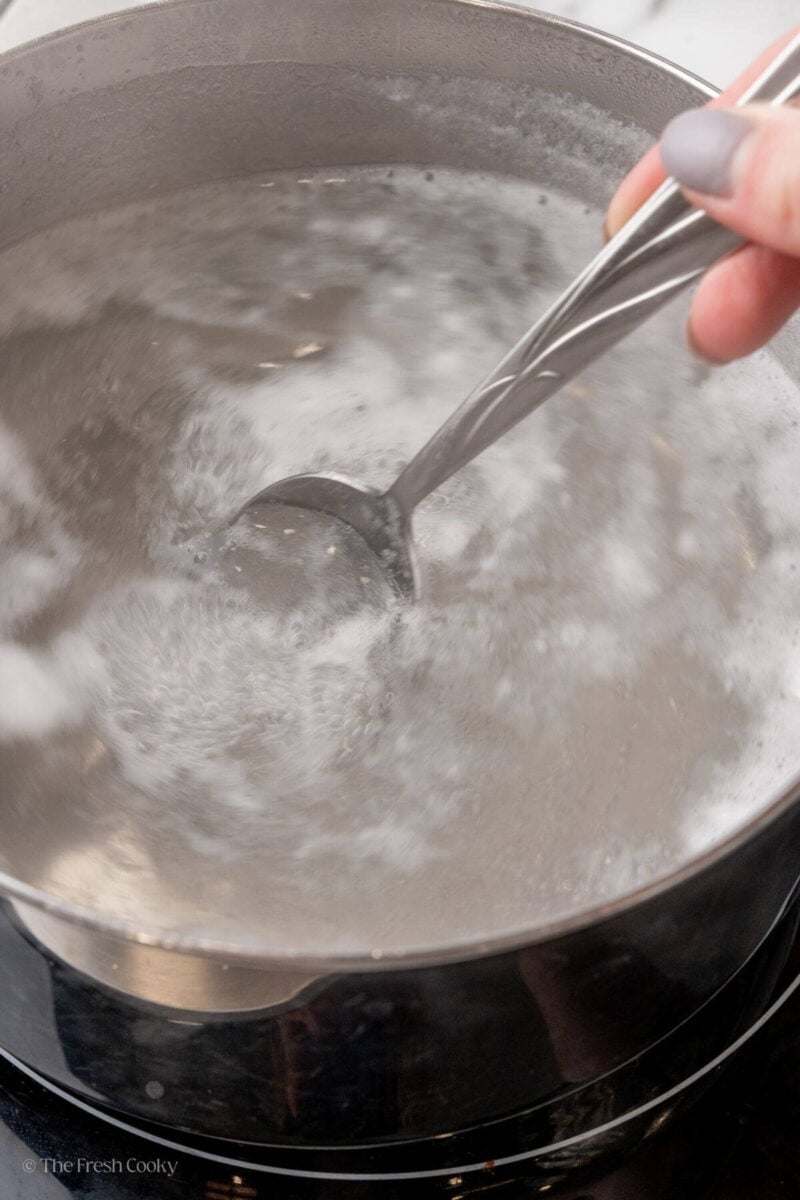
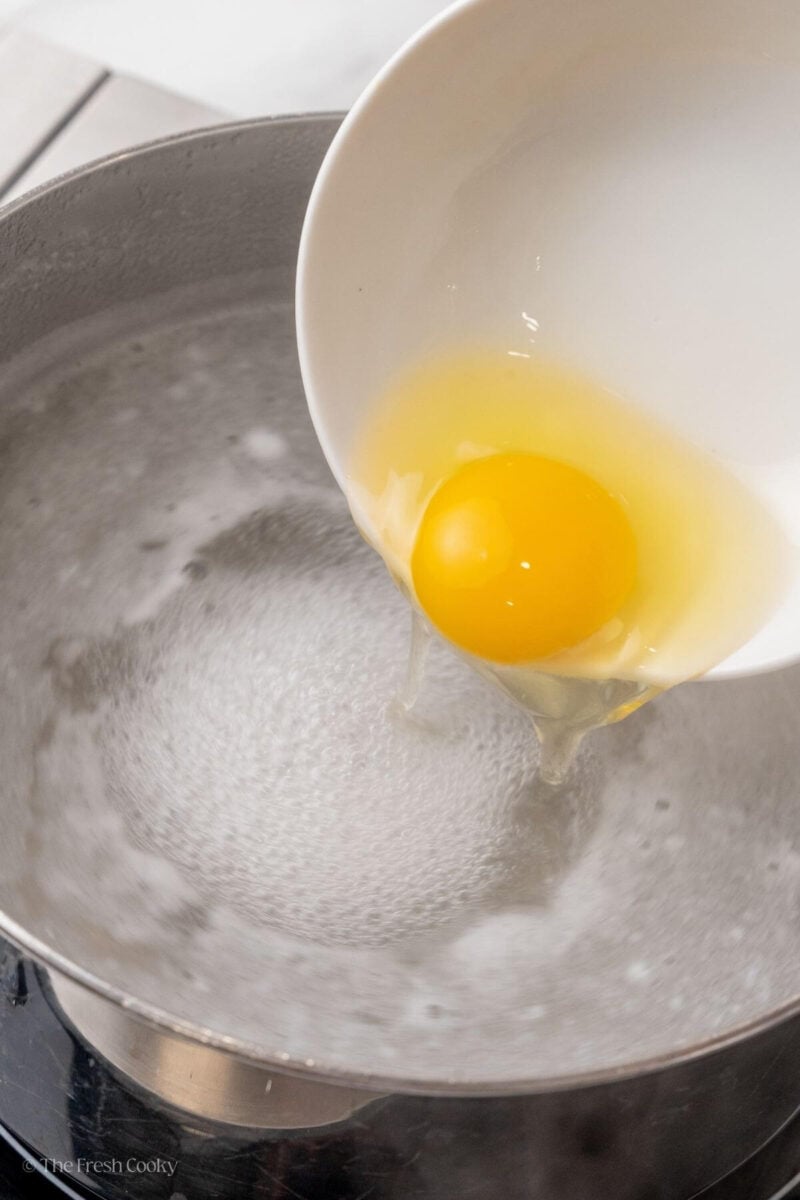
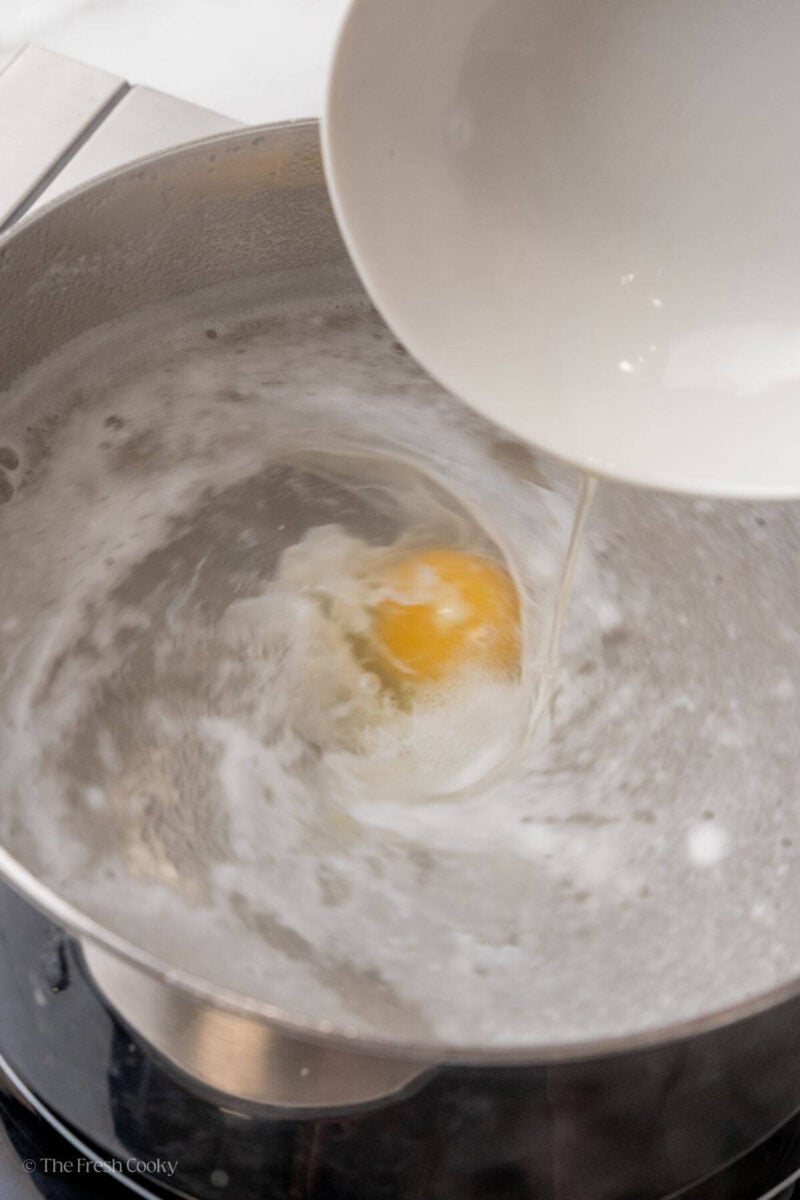
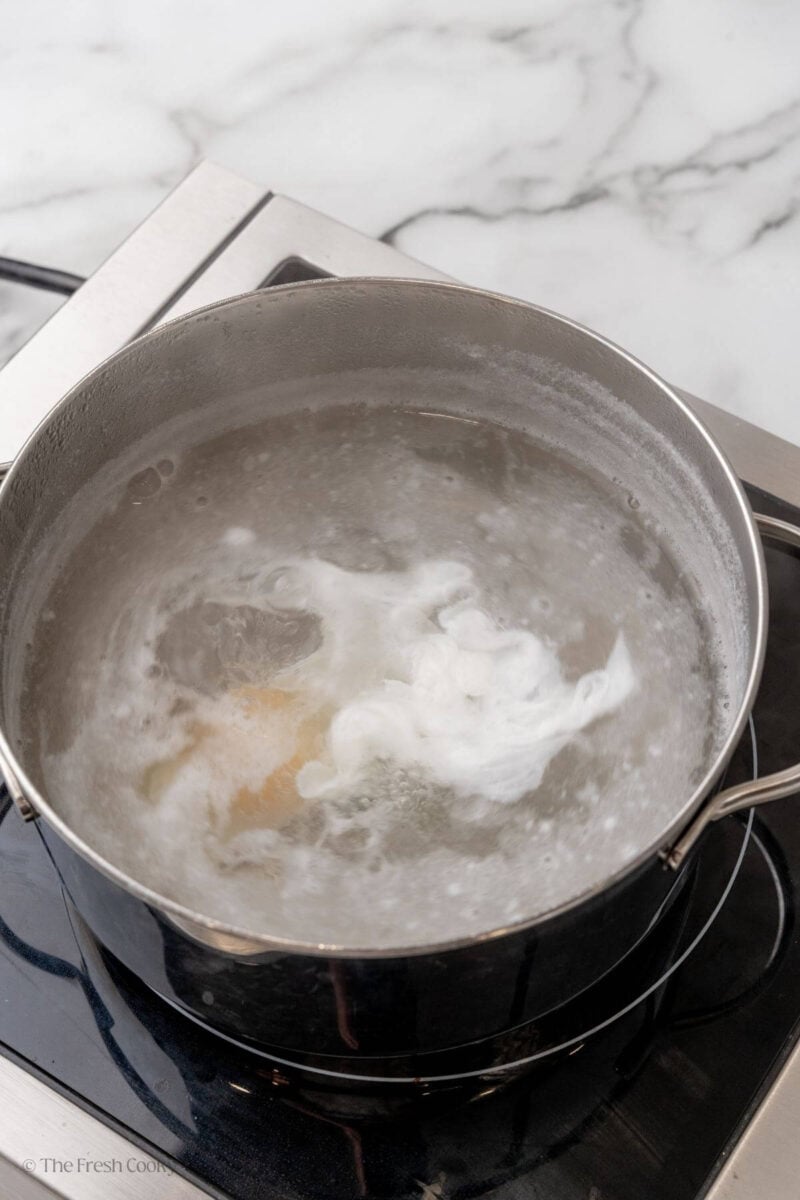
Step 4 – Make the Hollandaise Sauce
In a small blender or using an immersion blender in a deep bowl or cup, combine egg yolks, lemon juice, Dijon mustard, salt, and cayenne (or Tabasco). Blend for 20-30 seconds, or until the mixture is creamy and thick. With the blender running, slowly drizzle in HOT, melted butter until the sauce thickens and becomes smooth. Taste and adjust seasoning or lemon juice as needed. Use immediately.
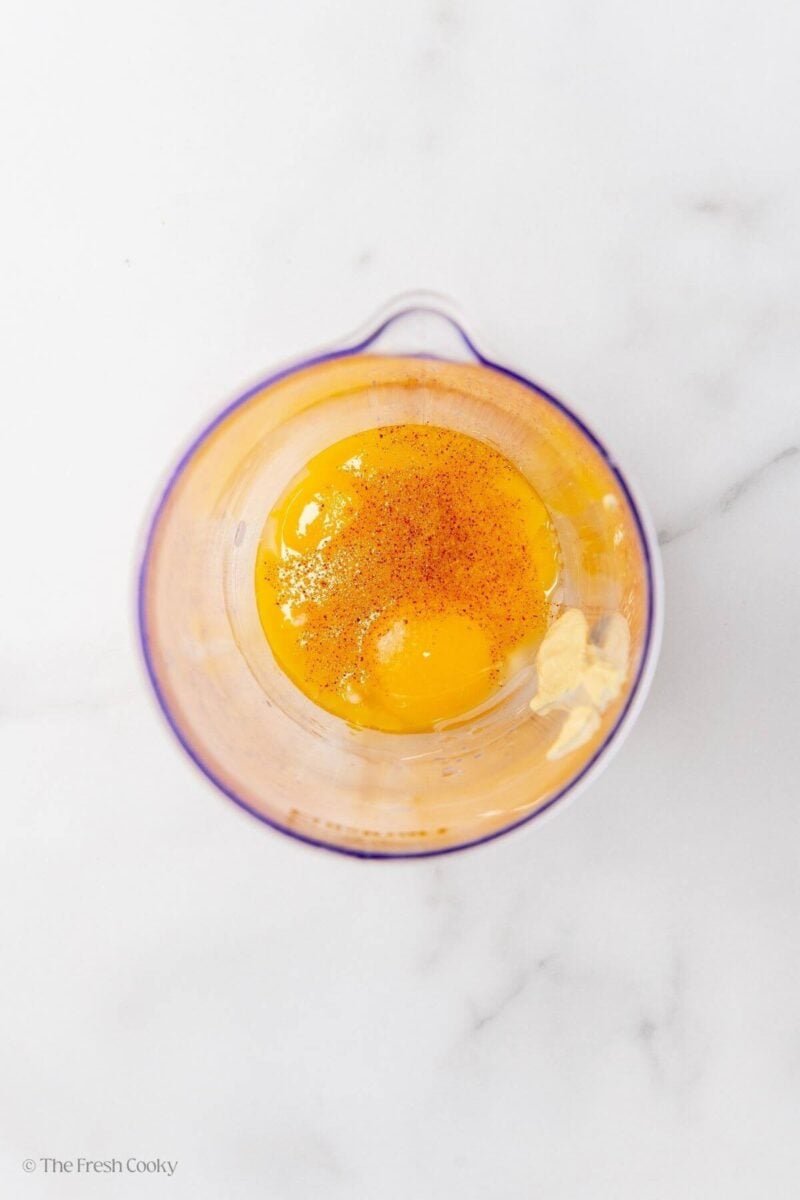
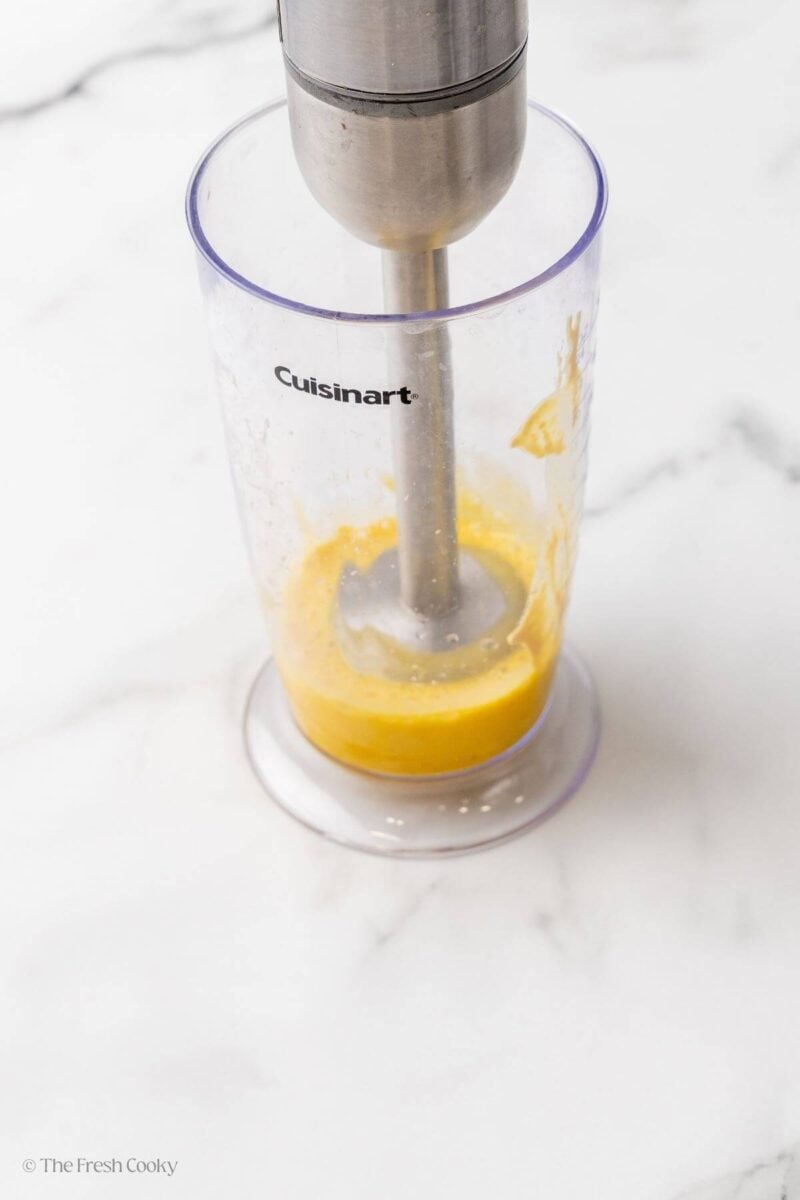
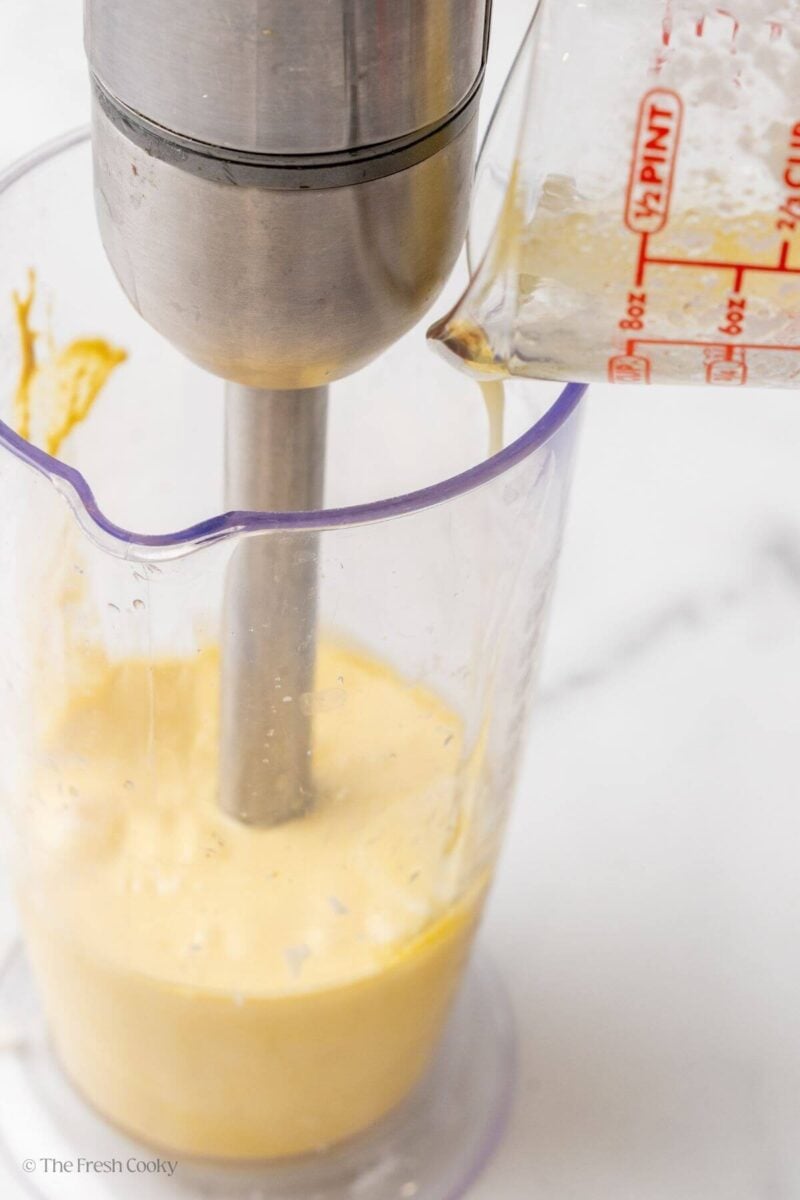
Step 5 – Assemble & Enjoy
Place a slice of Canadian bacon on each muffin half. Place a poached egg on top of the bacon, then pour or spoon warm hollandaise sauce generously over the top. Garnish with a little smoked paprika, chives, or parsley and serve immediately.

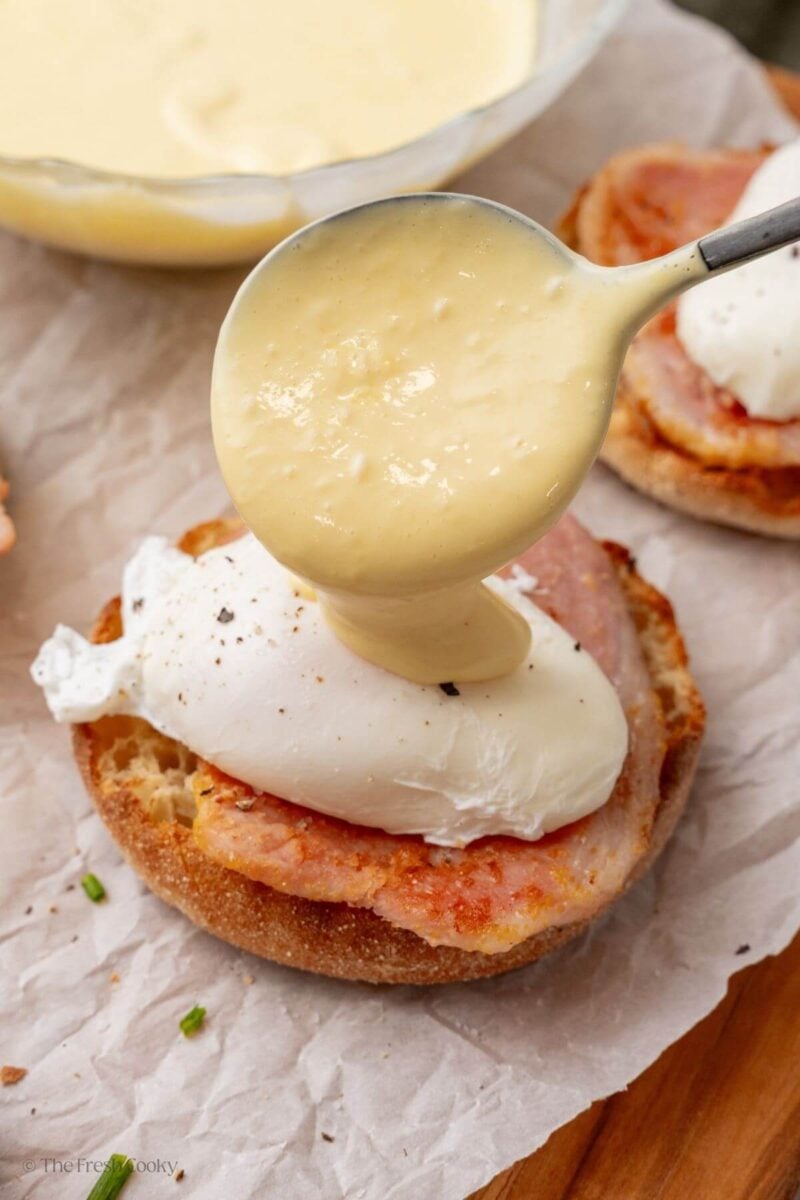
Eggs Benedict Variations
- Eggs Florentine: Replace Canadian bacon with sautéed spinach for a vegetarian option.
- Eggs Royale: Swap Canadian bacon for smoked salmon—perfect for seafood lovers.
- California Benedict: Add sliced avocado under the egg for a creamy twist.
- Irish Benedict: Replace the Canadian bacon with corned beef hash.
- Crab Benedict: Swap the Canadian bacon for lump crabmeat or a crab cake for a coastal twist. Top your toasted English muffin with crab, a poached egg and hollandaise. Sprinkle with Old Bay, chives or a squeeze of lemon. Pro Tip: If using plain crab, mix with a little melted butter, lemon juice and salt—it really brings out the flavor.
- Southern Eggs Benedict: Trade the English muffins for toasted buttermilk biscuits, then top with a poached egg and sausage gravy instead of hollandaise. Yum!
- Caprese Eggs Benedict: A low-carb option—layer a thick tomato slice with mozzarella, top with a poached egg and drizzle with hollandaise. Simple, fresh and so good.
Best Eggs Benedict Recipe Tips
- The hollandaise secret: Keep your butter HOT and your blender or immersion blender RUNNING while you slowly drizzle it in.
- Fix broken sauce fast: Add another egg yolk to a clean blender, then slowly blend in the broken sauce.
- Prep ahead: You can poach eggs up to a day in advance! After cooking, stop the cooking by gently transferring them to an ice water bath for 1 minute. Drain on paper towels, then store in an airtight container in the fridge for up to 24 hours.
- To reheat, let the eggs sit at room temperature for about 20 minutes, then gently lower into simmering (not boiling) water for 30–45 seconds until warmed through. Perfectly poached eggs, ready when you are!
- Keep everything warm: Assemble quickly once your hollandaise is ready—the sauce waits for no one!
How to Poach Eggs at High Altitude
I cook and bake at a mile high—5,280 feet above sea level—and one of the quirks of high-altitude cooking is that water boils at a lower temperature (approximately 202°F, instead of 212°F at sea level). This means poaching eggs takes a little more time to set the whites properly. This recipe was also tested at sea level!
If you’re at a higher elevation, add about one extra minute to your usual poaching time. At sea level, it’s typically 3½–4 minutes for a runny yolk and set whites, so at altitude you’ll likely need 4½–5 minutes, depending on your stove and pan. Mine were perfect jammy edges, runny center for me at 5 minutes; my hubby, on the other hand, likes his more jammy, so I simmered his for 6 minutes.
A few extra tips that help at high altitude:
- Use very fresh eggs—they hold their shape better.
- Add 1 teaspoon of vinegar to help the whites coagulate faster.
- Keep the water at a gentle simmer, not a boil (bubbling water can cause the eggs to break apart).
With a little extra time and care, you’ll still get perfectly poached, jammy-yolked eggs—even in thin air!

Eggs Benedict Origin
There are a few fun theories about the origin of this classic brunch dish. Some say Mrs. LeGrand Benedict asked for something new at Delmonico’s in New York City in the 1860s. Others credit Lemuel Benedict, who ordered toast, bacon, poached eggs, and hollandaise at the Waldorf Astoria Hotel in 1894 for a hangover cure. Then there’s Commodore E.C. Benedict, who supposedly had his own version, passed down by a family chef. Over time, the Waldorf story gained traction, thanks in part to mentions in The New York Times Magazine. But honestly, does it really matter? We’re just thankful someone came up with this divine brunch dish.
Classic Eggs Benedict FAQs
Eggs Benedict is a classic American breakfast or brunch dish with a toasted English muffin topped with Canadian bacon or ham, a poached egg, and hollandaise sauce.
The dish’s origin is disputed, but the most popular story credits a Wall Street broker named Lemuel Benedict who, in 1894, ordered buttered toast, poached eggs, crisp bacon, and a side of hollandaise at the Waldorf Hotel in New York to cure his hangover. The maître d’, Oscar Tschirky, was so impressed that he put it on the menu!
For best results, store components separately. Reheat English muffins in a toaster, warm the Canadian bacon in a skillet, and gently reheat poached eggs by placing them in simmering (not boiling) water for 30-45 seconds, to keep those classic runny yolks. Fresh hollandaise is best, but if you must reheat it, do so very gently in a bowl over warm water (in a double boiler), whisking constantly.

What to Serve with Eggs Benedict
Eggs Benedict is perfect for any brunch, but what should you pair with it? Here are some perfect accompaniments:
- Crispy breakfast potatoes
- Fresh fruit salad
- Simple green salad with light vinaigrette
- Air-fried asparagus
- Mimosas, Skinny Paloma or a Bloody Mary
- Fresh-squeezed orange juice
- Strong coffee

More Breakfast Recipes You’ll Love

Popular Recipes on The Fresh Cooky
Like this recipe?
Don’t forget to give it a ⭐️⭐️⭐️⭐️⭐️ star rating and leave a comment below the recipe!
Video
Ingredients
- 2 English muffins split and toasted (see notes for how to toast in oven)
- 4 large fresh eggs for poaching, check freshness dates (see notes for high altitude)
- 4 slices Canadian bacon or sliced ham, I like uncured nitrate free
- 1 teaspoon white vinegar for poaching water
- 1 tablespoon butter for browning bacon
- Chopped fresh chives, parsley, smoked paprika optional garnish
For the Blender Hollandaise Sauce:
- 3 large pasteurized egg yolks separate while cold, bring to room temperature
- 1-2 tablespoons fresh lemon juice to taste, more will make it tangier
- 1 teaspoon Dijon mustard or ½ teaspoon dry mustard
- 8-10 tablespoons unsalted butter melted and hot (if using salted butter, omit the salt)
- ¼ teaspoon kosher salt
- Pinch to ¼ teaspoon cayenne pepper or a few shakes of Tabasco sauce
Instructions
- Toast the English muffins until golden brown, butter if desired and set aside. Pro Tip: Place the toasted English muffin halves on a baking sheet and warm them in a 300ºF oven for 5-7 minutes—this keeps them crisp on the outside and soft inside.2 English muffins
- Melt butter in a skillet over medium heat. Cook bacon slices until lightly browned, 2-3 minutes per side. Set aside.1 tablespoon butter, 4 slices Canadian bacon
- Poach the eggs: Bring a medium-large saucepan filled with 3 inches of water to a boil, then reduce to a gentle simmer. Add vinegar. Stir the water using a spoon for 10 seconds to create a vortex. Add one egg to the center so the whites of the egg wrap around the yolk. Cook for 3 to 5 minutes or until the egg whites are cooked, but the yolk is runny. Remove with a slotted spoon to a paper-towel lined plate, use a seive to remove leftover eggwhites before poaching the next egg. Cook on the longer side for more jammy eggs. Reason with salt and pepper if desired. See tips if poaching at high altitude (in notes) and make ahead tips below.4 large fresh eggs, 1 teaspoon white vinegar
- Poach ahead! Cool eggs in ice water, then place on paper towels, refrigerate in air tight container up to 24 hours. When ready to reheat, bring to room temperature for 20 minutes, then place gently in hot water for 30-45 seconds—perfect for brunch crowds.
- Make the Hollandaise Sauce: In a small blender or using an immersion blender in a deep bowl, combine egg yolks, lemon juice, Dijon mustard, salt, and cayenne (or Tabasco). Blend for 20-30 seconds until creamy and thick.3 large pasteurized egg yolks, 1-2 tablespoons fresh lemon juice, 1 teaspoon Dijon mustard, 8-10 tablespoons unsalted butter, ¼ teaspoon kosher salt, Pinch to ¼ teaspoon cayenne pepper
- With the blender running, slowly drizzle in hot melted butter until the sauce thickens and becomes smooth. Taste and adjust seasoning or lemon juice as needed. Use immediately.
- Assemble: Place a slice of Canadian bacon on each half of the toasted muffin. Top with a poached egg. Spoon or pour warm hollandaise sauce generously over the top. Garnish with a little smoked paprika, chives or parsley and serve immediately.Chopped fresh chives, parsley, smoked paprika
Notes
How to toast English muffins in the oven
To toast English muffins in the oven, preheat your oven to 400ºF (205 °C) and split the muffins with a fork to preserve those signature nooks and crannies. Place them cut-side up on a baking sheet and bake for 8–10 minutes, or until golden and crisp. For extra crunch, flip them halfway through. If you prefer a softer inside with just a lightly crisp edge, toast them at 375ºF for 6–8 minutes instead.
Expert Tips for Making Hollandaise SauceIs Hollandaise Sauce Safe to Eat? Yes! The hot melted butter partially cooks the egg yolks as it blends, bringing the sauce to a safe temperature. It’s important to use pasteurized eggs. Always use hot, freshly melted butter—not lukewarm—to help heat the sauce and emulsify it correctly. The Secret is Hot Butter + a Running Blender: Temperature Matters—Your butter should be steaming hot, not just melted. Keep the blender running while you drizzle the butter in very slowly. This steady stream and motion create a smooth, glossy sauce. How to Fix a Broken Hollandaise Sauce:
- Whisk in a splash of hot water or warm lemon juice (a tablespoon at a time) while blending until the mixture comes together.
- Add another egg yolk to a clean blender, then slowly blend in the broken sauce to re-emulsify.
- If it looks greasy, the butter was likely added too fast or cooled too much—rewarming gently while whisking can help.
Poaching eggs at altitude can take a little longer since water boils at a lower temperature. Here’s how to get the best results:
- Use very fresh eggs—they hold together better.
- Add 1 teaspoon vinegar to the water to help set the whites.
- Keep water at a gentle simmer (not boiling).
- Swirl the water, then slide the egg in gently.




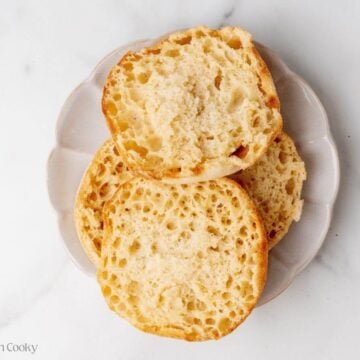

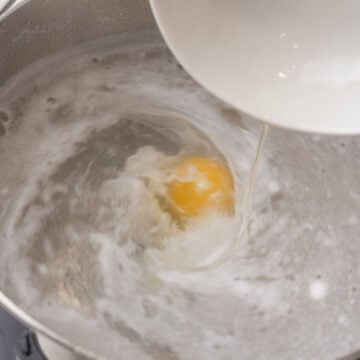
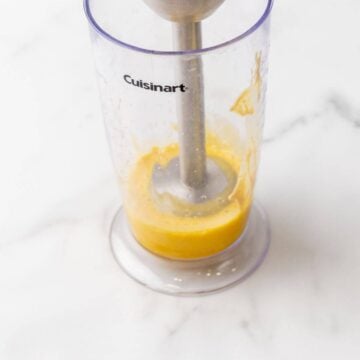

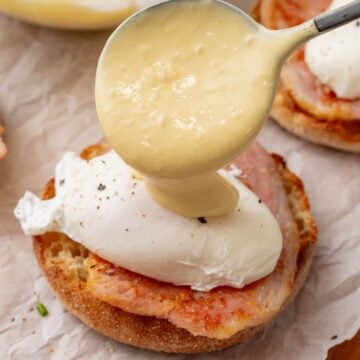
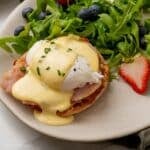

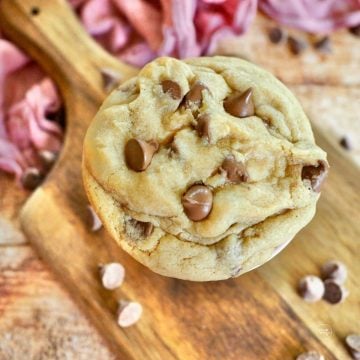
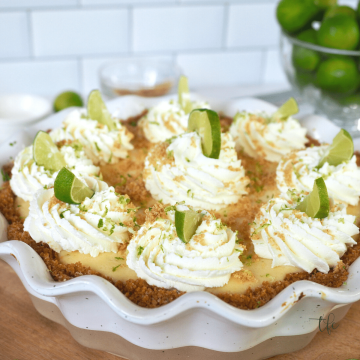
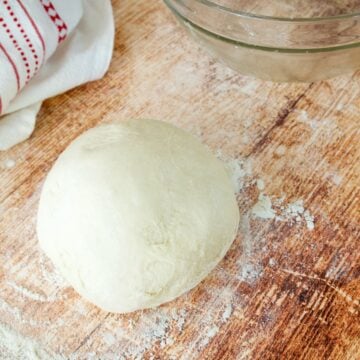

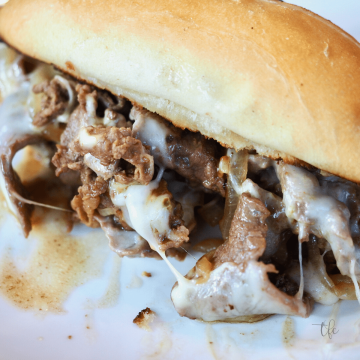
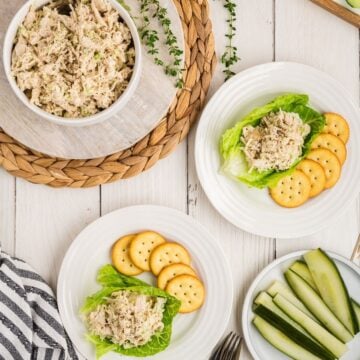
natalie
this felt like a gourmet brunch item, but it was so simple to make! will be making it more often!
Easier than you thought wasn’t it!